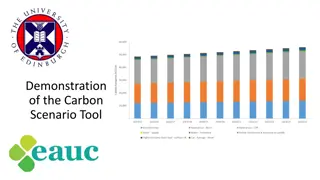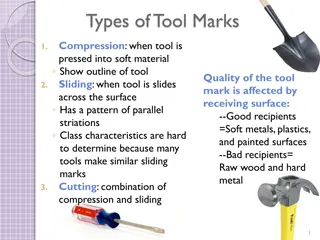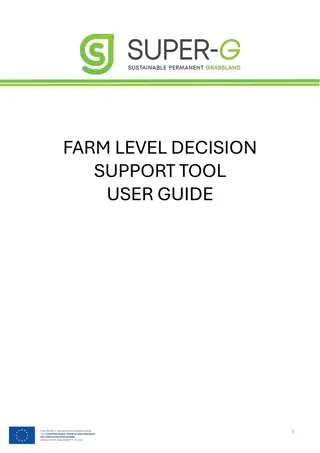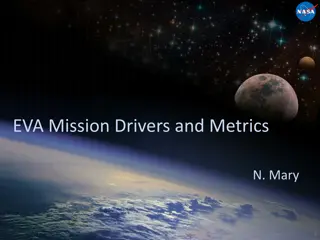EVA Tool Requirements Common Questions
This document outlines the common questions and requirements related to EVA tool handling, including hand clearances, sharp edge requirements, and upcoming updates. It provides essential guidelines for ensuring safety and efficiency during extravehicular activities.
Download Presentation

Please find below an Image/Link to download the presentation.
The content on the website is provided AS IS for your information and personal use only. It may not be sold, licensed, or shared on other websites without obtaining consent from the author.If you encounter any issues during the download, it is possible that the publisher has removed the file from their server.
You are allowed to download the files provided on this website for personal or commercial use, subject to the condition that they are used lawfully. All files are the property of their respective owners.
The content on the website is provided AS IS for your information and personal use only. It may not be sold, licensed, or shared on other websites without obtaining consent from the author.
E N D
Presentation Transcript
xEVA Compatibility Requirements Tamra George 5/22/2020 This document has been approved for public release per DAA 20205002693 and does not contain any export control information.
xEVA Requirements Documents The EVA Office is working toward public release of two documents. Thank you for your patience: 1) EVA Compatibility EVA-EXP-0035 2) Human Lunar Lander specific EVA Compatibility EVA-EXP-0070 In the mean time please look at these locations for what is available today: Draft version of EVA compatibility EVA-EXP-0070 document publically released last year. Although we have since updated the document this will at least give science teams a start: https://beta.sam.gov/api/prod/opps/v3/opportunities/resources/files/f2d5fc850fef29d71e20080d6c4c 9d3a/download?api_key=null&status=archived&token= There is also a public website for EVA: https://www.nasa.gov/suitup There is a battery safety requirements document that is required to be followed JSC20793 https://standards.nasa.gov/standard/jsc/jsc-20793
EVA Limitations Fatigue Tactile Feel Sharp Edge Cuts Touch Temperature Size Grip 3
EVA Tool Requirements Common Questions DISCLAIMER: The following slides are do not encompass ALL requirements. The ones in presentation are for discussion purposes only. 4
EVA Tool Requirements Common Questions Hand Clearances: Handles on payloads in EVA-EXP-0070 and EVA-EXP-0035 Hardware will be required to have a 2.25 inch clearance between handle and lower mounting surface for gloved hand clearance around handle. [EVASC.0004] [EVASC.0004] Figure side clearance of 4 inch defined in [EVASC.0005] Handle shall have a minimum grip length of 6 inches (15.2 cm). [EVASC.0030] [EVASC.0005] Figure Switches shall also consider spacing for gloved finger clearance in actuating switch travel. Switches/levers shall meet actuation forces. 5
EVA Tool Requirements Common Questions Cont. Sharp Edge Requirements in both 0035 and 0070 (reference [EVSC.0105]): 6
EVA Tool Requirements Common Questions Cont. Sharp Edge Requirements Continued: Minor modifications were made to this requirement in the updated 0070 that will be released at a later date. 7
EVA Tool Requirements Common Questions Cont. Live Voltage or RPG? The hardware provider shall design equipment to preclude exposure of electrical potential to the EVA crewmember. The hardware provider shall design any exposed conducting surfaces that are accessible to EVA crewmember contact (e.g. translation corridors, work areas, and incidental contact zones) to have a low resistance bond of 0.1 ohm or less to structure to alleviate shock hazards. The hardware provider shall preclude voltage potential discharge to an EVA suited crewmember at voltages above 40V. No they cannot carry an RTG nor have live voltage. Minor modifications were made to these requirements in the updated 0070 that will be released at a later date. 8
EVA Tool Requirements Common Questions Cont. Standard Testing: Standard testing includes but not limited to full functional, radiation, workmanship vibration and thermal. Main goal is to ensure zero hazards that could injure crew or mission. Battery Testing: Standard testing includes workmanship vibration and thermal. Radiation testing and other tests to ensure no hazardous condition may occur during operation. Testing to prove mitigation of thermal runaway propagation. Battery shall meet NASA-STD-20793 battery safety requirements document Nothing over 40V 9
EVA Tool Requirements Common Questions Cont. Communication Infrastructure: This is still in flux. The HLS Vendors may have different infrastructures. Mobility Assets: There will not be a rover in 2024 but team is working on cart/carrier to aid in carrying science instruments and tools to enable use in 2024. 10
EVA Tool Requirements Common Questions Cont. Work Envelope for Astronaut: The new xEMU has more mobility and will also be able to kneel on surface but for today please utilize this as reference [EVASC.0035]: 11
EVA We Can!!! Basic tools can use off the shelf if meet requirements: Ensure all materials are compatible for EVA environment (even greases and lubrications). Complex tools can be built: Takes more involvement of stakeholders to ensure interfaces and performs the required functions. More components within tool causes more testing and analysis Example cordless socket driver, leak locators, and Batteries
Off Shelf Example EVA Off Shelf
Simple Example EVA Off Shelf 14
Complex Example EVA Off Shelf 15
Fluid Line Quick Disconnects EVA Off Shelf 16
EVA Tool Reqmnts Include Many more requirements live in EVA-EXP-0035/0070. There are other documents for environments and vehicle launch loads. Materials: Not conducive to micro biological growth. Use metallic materials that are not susceptible to stress corrosion. Flammability, Odor, and Offgassing. Corrosion resistant. Material meets correct material properties Workmanship: Exposed corners and edges shall have EVA specified radius. All surfaces and edges shall be free of burrs. No exposed screw heads or threads that can lead to snags or sharp edges. 18
EVA Tool Reqmnts Include Cleanliness Operational Life Shelf Life Life Cycling of Mechanisms heating, vibration, acoustic noise, and shock in addition to quasi-static and dynamic loads. Maintains structural integrity when exposed to flight and non-flight environments, 19
EVA Tool Reqmnts Include Fracture Control margins of safety. Strength Requirements -> limit loads, ultimate loads, ultimate factors of safety, and Electrical Components Softgood Design temperature, and delta mating surface difference. Thermal Environment includes extreme non-operating temp, operating temp, touch 20
EVA Tool Reqmnts Include Human Factors: Drop Proof Tether Accommodation Alignment Marks Alignment Devices Pinch Points Hole Size Inadvertent Contact Loads Actuation Forces: Non-repetitive Actuation Force Repetitive Actuation Force Finger Actuation Force Actuation Torque Grip Surface Easily Visible Markings 21
EVA Tool Reqmnts Include One-handed, ambidextrous, engagement, disengagement, and operation. Driver-type hand tools shall not require a push force to maintain tool engagement while providing torque. Hand-Actuated Fasteners. Fasteners shall be operable by a single pressurized EMU glove. Fastener knobs shall be scalloped (unless driven by tool). 22
EVA Tool Reqmnts Include EVA Operable Connectors. Aligned and mated/demated using one hand, either right or left hand without the use of a tool. Spacing between connectors. Connectors shall be keyed so that it will be physically impossible to install in the wrong orientation. A feature shall be provided to indicate connector mating status. Connectors shall have tethered protective caps or covers to prevent physical damage and contamination. Connectors shall have visible alignment markings or other methods to ensure proper alignment during mating and demating. Electrical Connectors. The shells extend far enough beyond the pins to prevent pin contact with the mating connector shell during the mating operation. 23
EVA Tool Reqmnts Include Fluid and Gas Connectors. Pressurized pneumatic connectors and lines shall be tethered or otherwise captured to the main structure. Quick disconnect connectors shall be used for EVA. Connectors shall be capable of being vented prior to separation. Pressure Vibration
EVA Tool Reqmnts Include Other Standard Requirements: Plasma Radiation Bench handling Safety Sharp Edge/Entrapment/Pinchpoints EMU Touch Temperature Factors of Safety In Loads Electrical Shorting Due to Debris Shock Protection
EVA Certification Process Design Prototype Test With High Fidelity Mockups 1G Test With High Fidelity Mockups NBL Develop Final Design Review Process Materials Stress Safety Operations Electrical Pressure Systems























